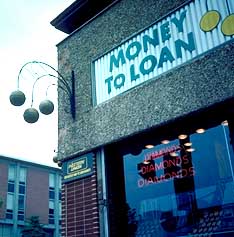Pawn Shop History
In the west, pawnbroking existed in the Ancient Greek and Roman Empires. Most contemporary Western law on the subject is derived from the Roman jurisprudence. As the empire spread its culture, pawnbroking went with it. Likewise, in the East, the business model existed in China 3000 years ago no different than today, through the ages strictly regulated by Imperial or other authorities.
Modern pawnbroker storefront.

In spite of early Roman Catholic Church prohibitions against charging interest on loans, there is some evidence that the Franciscans were permitted to begin the practice as an aid to the poor. Pawnbrokerage arrived in England with William the Conqueror, but known by the Italian name, Lombard. In 1338, Edward III pawned his jewels to raise money for his war with France. King Henry V did much the same in 1415. The Lombards were not a popular class, and Henry VII harried them a good deal. In 1603 an Act against Brokers was passed and remained on the statute-book until 1872. It was aimed at the many counterfeit brokers in London. This type of broker was evidently regarded as a fence. Queen Isabella of Spain pawned her jewelry to finance Christopher Columbus's first voyage to the New World.
Provident Loan Society of New York, a charitable pawnbroker
Crusaders, predominantly in France, brokered their land holdings to monasteries and diocese for funds to supply, outfit, and transport their armies to the Holy Land. Instead of outright repayment the Church reaped a certain amount of crop returns for a certain amount of seasons, which could additionally be re-exchanged in a type of equity.

A pawnbroker can also be a charity. In 1450, Barnaba Manassei, a Franciscan monk, began the Monte di Pietà movement in Perugia, Italy. It provided financial assistance in the form of no-interest loans secured with pawned items. Instead of interest, the Monte di Pietà urged borrowers to make donations to the Church. It spread through Italy, then to other parts of Europe. The first Monte de Piedad organization in Spain was founded in Madrid, and from there the idea was transferred to New Spain by Pedro Romero de Terreros, the Count of Santa Maria de Regla and Knight of Calatrava. The Nacional Monte de Piedad is a charitable institution and pawn shop whose main office is located just off the Zocalo, or main plaza of Mexico City. It was established between 1774 and 1777 by Pedro Romero de Terreros as part of a movement to provide interest-free or low-interest loans to the poor. It was recognized as a national charity in 1927 by the Mexican government. Today it is a fast-growing institution with over 152 branches all over Mexico and with plans to open a branch in every Mexican city.
The economic downturn of 2008 saw the advent of the online pawnbrokers such as Borro, who offered customers the chance to gain finance against their assets without ever entering a pawn shop.
Source: Wikipedia
